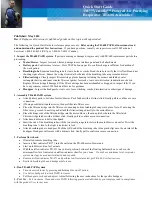
Important Installation Notes for Air
Seal
Ambient
Air
Path
Enclosure
Internal Air
Path
Mounting Styles:
Vertical (Side/Front/Back) Mounting:
Condensate Removal System:
Top Mounting:
Maintenance:
Cautions:
Notes on condensation:
Both ‘thru mount’ and ‘flush mount’ units can be
positioned in any orientation and on any enclosure surface. It is important
to consider interior air flow patterns when determining the mounting
location. Also of importance is an unrestricted flow of ambient air thru
the hot side heat exchanger. Ease of access and inspection must
be considered for those applications in particularly severe
environments which may require occasional maintenance.
Vertical mounting refers to the vertical direction of the cold
side or interior fins and is recommended for applications with
high humidity, poor and incomplete cabinet seals or any
condition which may cause the cold side fins to be maintained
at temperatures below the dew point for long periods of time
allowing for the formation of condensation. The vertical fin
direction provides a drip path whereupon condensation can be
collected via a moisture removal system (standard on FHP-
units) or a drip pan positioned below the cold side fins. Drip pans are
optional for thru mount units.
All FHP-Series and AHP-1400 air conditioners contain a built-in condensate removal system. The condensate kit
consists of a antifungal sponge with a condensate wick. PVC tubing is also provided for drainage. Drip pans are
optional for thru mount units which must be evaluated on an individual basis. Equations defining a relationship between
the cold side fin and enclosure temperatures are provided to assist in the evaluation.
Though often the easiest location to mount it is often the most difficult to protect from condensation in this orientation
due to the fin orientation, gravity and any susceptible components below. If a drip pan is employed by the end user use
caution to place the pan far enough away from the internal fan to minimize the restriction of air flow. The pan should
cover the fin ends as well as the fan area. When there is a choice, the vertical orientation is preferred by most
users.
Since the technology is solid-state, there are no filters, compressors, or fluorocarbons to maintain. The only moving
parts are the fans.
It is recommended for harsh or dirty environments that the heat sinks be cleaned from time to
time. This can be accomplished by directing compressed air over the external fins or on NEMA 4 versions by hosing
the unit down. This will increase the overall life and performance of the system.
Take care when mounting not to damage the seal between the hot and cold side sinks. Do not attempt to mount a unit
to a warped surface or try to make the units mounting surface conform to an unflat surface. Do not pinch or damage
any leads when mounting. Do not over tighten any installation screw, use reasonable force. Always mount with any
condensate drain down. Do not compress the cold side between the hot side and any other surface. Do not obstruct
the airflow on either side. When mounting consider the natural air flows of the enclosure. Connect power only after the
installation is complete.
Condensation occurs at the cold side fins when the surface temperature goes below the dew point. To reduce or
remove condensate, consider the following:
• Regulate the Fin Temperature above the Dewpoint.
• Keep Enclosure Closed and Sealed from Outside Humidity.
• Use Desiccant (Moisture absorbing Granules.)
• Employ Condensate Removal System/Drip Pans.
If you have any questions regarding your installation, Please feel free to contact our technical department for assistance
at 773-342-4900.



























